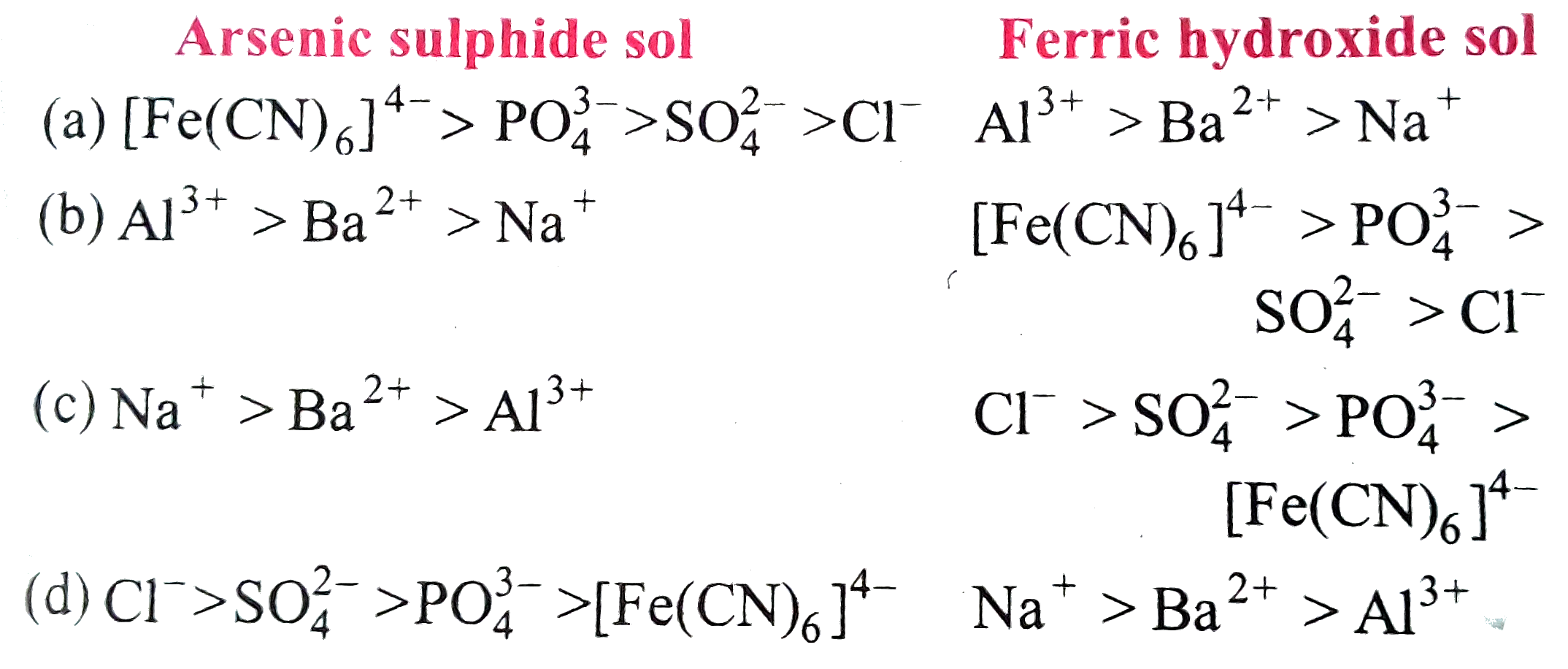The coagulating power of an effective ion carrying the charge opposite to the sol particles has been illustrated by :-
The correct Answer is:D
To solve the question regarding the coagulating power of an effective ion carrying the charge opposite to the sol particles, we can follow these steps:
1. Understanding Coagulation: Coagulation refers to the process where colloidal particles aggregate to form a precipitate. This process is influenced by the presence of ions in the solution.
2. Identifying the Role of Ions: The ions that can cause coagulation must carry a charge opposite to that of the colloidal particles. For example, if the colloidal particles are negatively charged, then positively charged ions will be effective in coagulating them.
3. Hardy-Schulze Rule: The coagulating power of an electrolyte is quantitatively described by the Hardy-Schulze rule. This rule states that the effectiveness of an ion in coagulating a colloidal solution is directly related to its valency.
4. Valency and Coagulation Power: According to the Hardy-Schulze rule, ions with higher valency are more effective in coagulating colloidal particles. For instance, a divalent ion (charge of +2) will have a greater coagulating power than a monovalent ion (charge of +1).
5. Conclusion: Therefore, the coagulating power of an effective ion carrying the charge opposite to the sol particles is illustrated by the Hardy-Schulze rule, which emphasizes the importance of the valency of the coagulating ion.
Final Answer:
The coagulating power of an effective ion carrying the charge opposite to the sol particles has been illustrated by the Hardy-Schulze rule.
The coagulating power of an effective ion carrying the charge opposite to the sol particles has been illustrated by the Hardy-Schulze rule.
Topper's Solved these Questions
- SURFACE CHEMISTRY BOOK - ALLENCHAPTER - SURFACE CHEMISTRY EXERCISE - EXERCISE -2
21 Videos
- SURFACE CHEMISTRY BOOK - ALLENCHAPTER - SURFACE CHEMISTRY EXERCISE - ASSERTION & REASO
20 Videos
- Some Basic Concepts of Chemistry (Mole concept)BOOK - ALLENCHAPTER - Some Basic Concepts of Chemistry (Mole concept)EXERCISE - All Questions
39 Videos
- TEST PAPERBOOK - ALLENCHAPTER - TEST PAPEREXERCISE - Exercise (Chemstry)
26 Videos
Similar Questions
coagultion is the process by which the dispersed phase of a colloid is made to aggregate and thereby separtate from the continuous phase. The minimum concetration of an eletrolyte in milli-moles per litre of the electrolyte solution which required to cause the caogultion of colloidal sol is called coagution value .
therefroe higher is the coagulatings power of effective ion, smaller will be the coagultion value of the electrolyte.
the ability of an ion to bring about coagulation of a given colloid depends upon :
View Solutioncollodial particles in a sol can be coagulated by :
View Solution
Knowledge Check
Which of the following statements are correct ?
(i) When an animal hide, which has negatively charged particles , is soaked in tannin, which contains positively charged colloidal particles, mutual coagulation does not take place.
(ii) Photographic films are prepared by coating an emulsion of the light sensitive silver bromide in gelatin over glass plates or celluloid films.
(iii) Latex is a colloidal solution of rubber particles which are negatively charged.
(iv) In Cottrell precipitator , the smoke , before it comes out from the chimney, is led through a chamber containing plates having a charge opposite to that carried by smoke particles. The particles on coming in contact with these plates acquire some charge and do not get precipitated .A(i) and (iv) onlyB(ii) and (iii) onlyC(ii), (iii) and (iv) onlyDAll of these.
coagultion is the process by which the dispersed phase of a colloid is made to aggregate and thereby separtate from the continuous phase. The minimum concetration of an eletrolyte in milli-moles per litre of the electrolyte solution which required to cause the caogultion of colloidal sol is called coagution value .
therefroe higher is the coagulatings power of effective ion, smaller will be the coagultion value of the electrolyte.
coagultion value ∝=1coagulating power
the coagulation values of differnt electrolytes are different . this behavious can be easily uderstood by Harby - schulze rule which states.
the greater is the valency of the effective ion grreater is its coagulating power,"
which one had the highest coagulating powe?
View SolutionThe coagulation of sol particles may be brought in by :
View Solutioncoagultion is the process by which the dispersed phase of a colloid is made to aggregate and thereby separtate from the continuous phase. The minimum concetration of an eletrolyte in milli-moles per litre of the electrolyte solution which required to cause the caogultion of colloidal sol is called coagution value .
therefroe higher is the coagulatings power of effective ion, smaller will be the coagultion value of the electrolyte.
the coagulation of colloidal particles fo the sol can be caused by :
View SolutionThe correct order of the flocculating power in the
coagulation of a positive sol is
View SolutionThe correct order ofr flocculating power of the given ions for the specified colloidal sols will be

View Solutioncoagultion is the process by which the dispersed phase of a colloid is made to aggregate and thereby separtate from the continuous phase. The minimum concetration of an eletrolyte in milli-moles per litre of the electrolyte solution which required to cause the caogultion of colloidal sol is called coagution value .
therefroe higher is the coagulatings power of effective ion, smaller will be the coagultion value of the electrolyte.
As2S3sol si negatively charged. Capacity to perciopitate of a given colloid depends upon :
View SolutionWhich out of the following solutions having the same concentration will be most effective in causing the coagulation of the arsenic sulphide sol which is yellowing colour: KCl,MgCl2,AlCl3orNa3PO4 ?
View Solution
